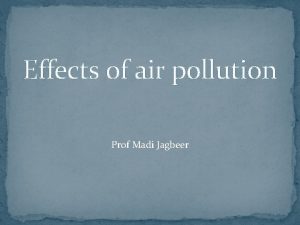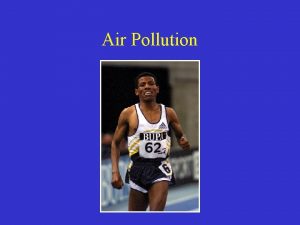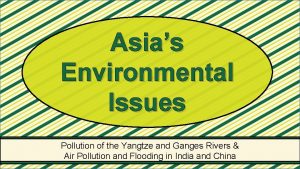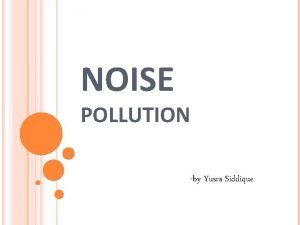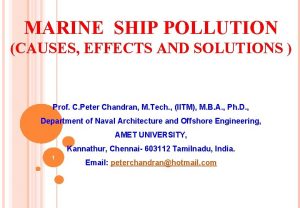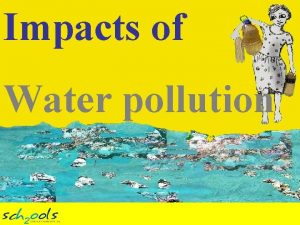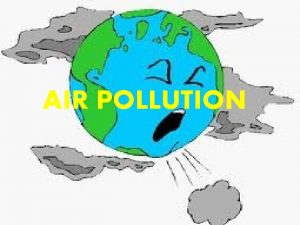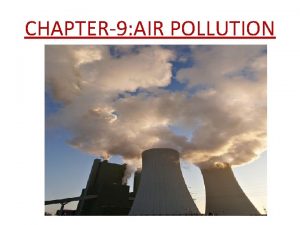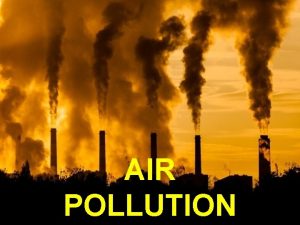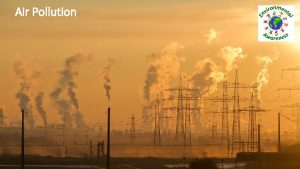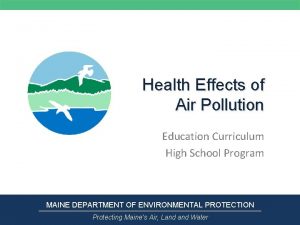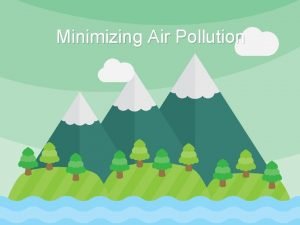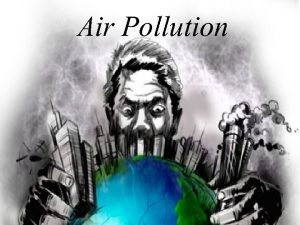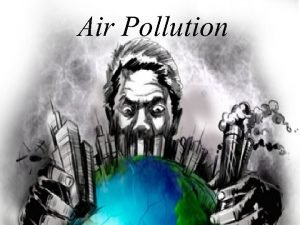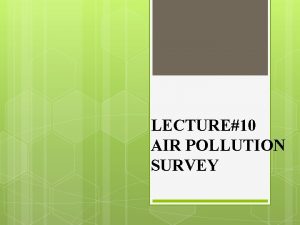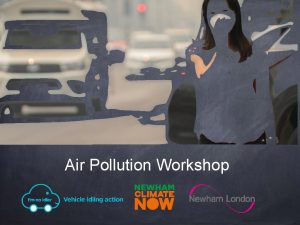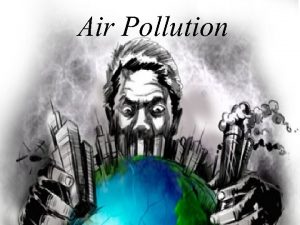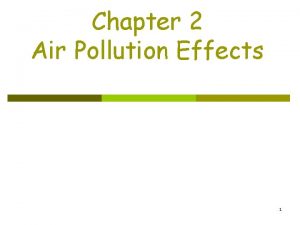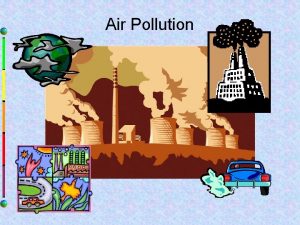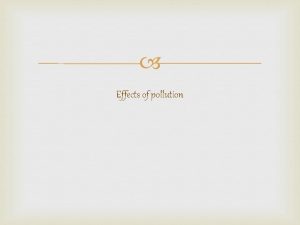Health Effects of Air Pollution Education Curriculum High






















- Slides: 22

Health Effects of Air Pollution Education Curriculum High School Program MAINE DEPARTMENT OF ENVIRONMENTAL PROTECTION Protecting Maine’s Air, Land Water

Why Should We Care About Air Pollution?

Air Pollution • The Clean Air Act requires EPA to set National Ambient Air Quality Standards (NAAQS) for six common air pollutants (also known as “criteria air pollutants"). • These pollutants are found all over the U. S. , some from natural sources and some from man-made sources. • They can harm your health and the environment, and cause property damage.

Criteria Air Pollutants • • • carbon monoxide lead ground-level ozone particulate matter nitrogen dioxide sulfur dioxide

Carbon Monoxide • Incomplete oxidation of carbon results in the production of carbon monoxide. – Natural CO formation occurs from photochemical reactions in the troposphere, volcanoes, forest fires, etc. • Breathing air with a high concentration of CO reduces the amount of oxygen that can be transported in the blood stream to critical organs like the heart and brain. • At very high levels, which are possible indoors or in other enclosed environments, CO can cause dizziness, confusion, unconsciousness and death.

Lead • Sources of lead emissions vary from one area to another. – At the national level, major sources of lead in the air are ore and metals processing and piston-engine aircraft operating on leaded aviation fuel. – Other sources are waste incinerators, utilities, and lead-acid battery manufacturers. The highest air concentrations of lead are usually found near lead smelters. – Volcanic activity and airborne soil are the primary natural sources of atmospheric lead.

Lead • As a result of EPA's regulatory efforts including the removal of lead from motor vehicle gasoline, levels of lead in the air decreased by 98 percent between 1980 and 2014.

Lead • Once taken into the body, lead distributes throughout the body in the blood and is accumulated in the bones. • Depending on the level of exposure, lead can adversely affect the nervous system, kidney function, immune system, reproductive and developmental systems and the cardiovascular system. • Lead exposure also affects the oxygen carrying capacity of the blood.

Ground Level Ozone • Ozone is formed in the atmosphere when energetic ultraviolet (UV) radiation dissociates molecules of oxygen, O 2, into separate oxygen atoms. • Free oxygen atoms can recombine to form oxygen molecules but if a free oxygen atom (O-2) collides with an oxygen molecule(O 2), it joins up, forming ozone (O 3).

Ozone • Breathing ozone can trigger a variety of health problems, particularly for children, the elderly, and people of all ages who have lung diseases such as asthma. • Ground level ozone can also have harmful effects on sensitive vegetation and ecosystems.

Ozone

Particulate Matter • Sea salt, soil dust, volcanic particles, smoke from forest fires account for particulate emissions each year. • Small particles are removed from the atmosphere by accretion to water droplets, which grow in size until they are large enough to precipitate. • Larger particles are removed by direct washout by falling raindrops.

Particular Matter EPA groups particle pollution into two categories: • "Inhalable coarse particles, " such as those found near roadways and dusty industries, are larger than 2. 5 micrometers and smaller than 10 micrometers in diameter. • "Fine particles, " such as those found in smoke and haze, are 2. 5 micrometers in diameter and smaller. These particles can be directly emitted from sources such as forest fires, or they can form when gases emitted from power plants, industries and automobiles react in the air.

Particulate Matter

Particulate Matter Particulate matter contains microscopic solids or liquid droplets that are so small that they can be inhaled and cause serious health problems.

Nitrous Oxides • Nitrogen Dioxide (NO 2) is one of a group of highly reactive gases known as oxides of nitrogen or nitrogen oxides (NOx). • Although some is naturally occurring, NO 2 primarily gets in the air from the burning of fuel. • NO 2 forms from emissions from cars, trucks and buses, power plants, and off-road equipment.

Nitrous Oxides • Breathing air with a high concentration of NO 2 can irritate airways in the human respiratory system. – Such exposures over short periods can aggravate respiratory diseases, particularly asthma, leading to respiratory symptoms (such as coughing, wheezing or difficulty breathing), hospital admissions and visits to emergency rooms. – Longer exposures to elevated concentrations of NO 2 may contribute to the development of asthma and potentially increase susceptibility to respiratory infections. People with asthma, as well as children and the elderly are generally at greater risk for the health effects of NO 2. – NO 2 along with other NOx reacts with other chemicals in the air to form both particulate matter and ozone. Both of these are also harmful when inhaled due to effects on the respiratory system.

Sulfur Oxides • The largest source of SO 2 in the atmosphere is the burning of fossil fuels by power plants and other industrial facilities. Smaller sources of SO 2 emissions include: – industrial processes such as extracting metal from ore – natural sources such as volcanoes – and locomotives, ships and other vehicles and heavy equipment that burn fuel with a high sulfur content.

Sulfur Oxides • At high concentrations, gaseous SO 2 can harm trees and plants by damaging foliage and decreasing growth and can contribute to acid rain which can harm sensitive ecosystems. • Short-term exposures to SO 2 can harm the human respiratory system and make breathing difficult. Children, the elderly, and those who suffer from asthma are particularly sensitive to effects of SO 2.

NASA: U. S. air quality improving (1: 55)

What is the Air Quality Today in Your Town?

www. maine. gov/dep
 Effect of air pollution to plants
Effect of air pollution to plants General effects of air pollution
General effects of air pollution 5 effects of air pollution
5 effects of air pollution Effects of land pollution on human health
Effects of land pollution on human health How to avoid noise pollution
How to avoid noise pollution Chapter 12 air section 1
Chapter 12 air section 1 Chapter 12 air section 1 what causes air pollution
Chapter 12 air section 1 what causes air pollution Hubungan air dengan tanah
Hubungan air dengan tanah Victorian curriculum health and physical education
Victorian curriculum health and physical education Victorian curriculum health and physical education
Victorian curriculum health and physical education Cdc hecat
Cdc hecat Cdc hecat
Cdc hecat Water pollution
Water pollution Air pollution consequences
Air pollution consequences Pollution causes effects and solutions
Pollution causes effects and solutions Pollution causes effects and solutions
Pollution causes effects and solutions Effects of water pollution
Effects of water pollution What are 5 effects of water pollution?
What are 5 effects of water pollution? Conclusion of soil pollution
Conclusion of soil pollution 8 effects of water pollution
8 effects of water pollution Difference between health education and promotion
Difference between health education and promotion Difference between health education and propaganda
Difference between health education and propaganda Land water and air pollution
Land water and air pollution
